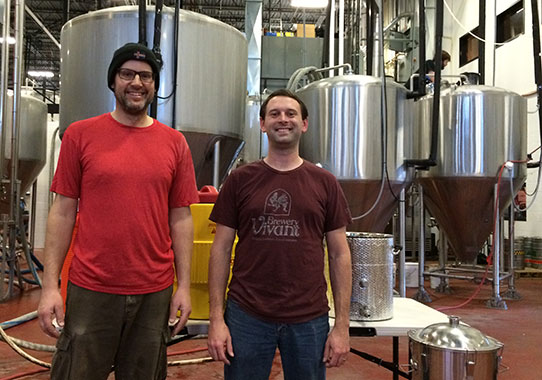Learn to brew with a craft brewing certificate

John Schuppel, left, completed the Craft Brewing Certificate Program at Madison College and now works for Ale Asylum along with Joe Waltz, right, the quality control manager at the brewery.
December 10, 2015
As the craft brewing market continues to grow, Madison College has instituted a Craft Brewing Certificate Program.
Students 21 and older can now enroll in classes to earn their Craft Brewing Certificate. The program is geared to both those looking to get into the industry as well as those looking to enhance their home brewing skills.
The Craft Brewing Certificate Program is run through The School of Professional and Continuing Education. Dean Kathleen Radinoff began talking about creating the program two and half years ago with Kevin Appleton, the program’s director. Radinoff and Appleton had previously worked together on several food and cooking programs. Appleton is a chef and teaches first year students in the Culinary Arts Program. According to Appleton, Radinoff recognized the potential of the craft beer market and knew it would only continue to grow. At that time, other schools throughout the country had begun launching similar programs, and Radinoff declared a similar program at Madison College, “A natural for us.”
Appleton spent a year and a half researching similar programs launched by other schools. During this time, he partnered with Otto Dilba and Dean Coffey, the founders Ale Asylum, a local brewery most known for The APA (American Pale Ale) Hopalicious, to shape the program. “We basically asked [them], ‘If you’re hiring somebody, what would give them a leg up?’” said Appleton. He went on to say that program was “really based around that information.”
Students who enroll in the program will get hands-on experience on the floor of Capital Brewing Co. in a practicum hosted by Joe Waltz, Quality Control Manager at Ale Asylum. Ale Asylum could not host the April practicum, so Capital Brewing Co stepped in to help, much to the surprise of Appleton. “It’s so interesting,” Appleton said, “It turns out the brewing community is a very supportive community…the craft brewing community is a real community.”
The program is divided into three core classes. The first class is Brewing and Essentials. Here, students will learn about brewing processes, historical areas of brewing, styles, pairings, and serving practices. Second is Microbiology and Fermentation, in which students will learn about the science behind beer brewing. Students will study such subjects as sanitation, yeast, yeast life cycle, malting, the fermentation process, and water chemistry. According to Appleton, the ultimate goal of the class is to understand “The theory behind,” he waives his hand, “to help you understand or troubleshoot when you’re brewing, to get what you want.” The third class is the Brewing Practicum – Hands-On Brewing Production and Evaluation.
As the fall semester comes to an end, several students have already begun to find work. Ale Asylum has hired two students, and Lucky’s has hired a third. While Appleton is confident in what the program can offer students, he emphasizes the necessity of experience, and that expectations should be managed. According to Appleton, many students come into the program having home brewed for years. “There’s a lot that goes into it,” he says. “Some of it is just getting to work at a brewery; we believe going through the program definitely gives you a real leg up and will help get someone to take a look at you and bring you in at the beginning level.” Appleton stresses that students shouldn’t expect to become a lead brewer anywhere, comparing it to the culinary program: “You don’t graduate from the culinary program and open your restaurant or have your food shown someplace. You have to work your way up through the ranks.” While not prepared to reveal with whom, Appleton did say he was working on setting up internships with a business.
Though the Craft Brewing Certificate Program is less than one year old, Appleton already has plans for the future. He says he would like to expand and introduce more classes on subjects such as cider and mead, food and pairing, and tasting. Dean Coffey has also approached Appleton with ideas for classes, including a follow-up practicum class. Coffey stressed to Appleton that once students graduate, they have to go home and continue to brew. The idea is for students to bring in samples of what they brew at home and taste it as a group. Another one of Coffey’s ideas is for business classes where students can study the brewing industry and develop their own business plans.
The craft brewing market is ever-growing. According to Justin Cantoni, who teaches the Brewing and Essentials class, “Craft beer has exploded in mainly the last five years, but it goes farther back – since the 2000s.” When he’s not teaching, Cantoni works as the Craft Beer Specialist at Wirtz Beverage Co. He estimates that craft beer sales now account for 14-18 percent of all beer sales. In the pre-prohibition United States, there were an estimated 1,179 breweries. By 1935, two years after prohibition had ended, there were 703 breweries in the United States, but by 1980 there were fewer than 100. In 2014, the Brewers Association had the total of 3,464 breweries.






























